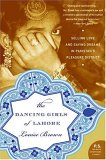Summary | Excerpt | Reading Guide | Reviews | Beyond the Book | Readalikes | Genres & Themes | Author Bio

Selling Love and Saving Dreams in Pakistan's Ancient Pleasure District
by Louise Brown"We Were Artists . . . Not Gandi Kanjri"
(Hot Season: April - June 2000)
Lahore is a wonderful city with rich character and a worn charm.
The Mughal Empire has bequeathed some glories to the modern city: the
awe-inspiring Badshahi Masjid; the imposing Shahi Quila, or Royal Fort; the
pretty Shalamar Gardens; and the now dilapidated tombs of Emperor Jahangir and
his empress, Nur Jahan. Grand buildings inherited from the British raj sit in
stately, shabby order on the broad, leafy Mall Road running through the center
of town. New suburbs have grown -- some affluent and some not. The streets and
markets bustle and hum with life and the mosques and mausoleums are always busy.
Best of all, though, is this ancient place -- the Walled City -- a quarter of a
million people squeezed into a square mile of congested tenements and shops. It
is the heart of Lahore and it carries the city's soul.
Old Lahore can't have changed much for centuries. The moat was
filled in long ago and the defensive walls have gone, but the residents,
constrained by ancient land boundaries and historical memory, continue to build
their houses as if the walls still exist: an ageless and invisible presence. The
thirteen gates into the city remain too, channeling pedestrians and traffic from
the wide roads of contemporary Lahore into the narrow lanes and alleys of the
Walled City. Rickshaws, horse-drawn carts called tangas, motorbikes, and small
vans compete with pedestrians for space inside the walls. No vehicles of any
kind enter the narrowest alleys. Neither does the sun. Only in the wider lanes
and the bazaars does the sun shine directly on the ground. Most of the small
passages running through the city lie in perpetual, dusty gloom.
Early morning is the best time to see the old city. During the
hot season there are a couple of hours before the temperature soars and the
lanes become too congested. The city wakes up and life unfolds in much the same
way it must have done hundreds of years ago. The shopkeepers are busy: the
butchers slice up chickens and goats, the tea shops open and the bakers prepare
halva and fry puri for the first meal of the day. The fruit and vegetable
sellers arrange their produce in a kaleidoscope of bright colors: plump
aubergines, mooli, red carrots, sweet firm tomatoes, bundles of spinach, fresh
okra, and leafy bunches of coriander and mint. Donkey carts rattle and creak
down the galis, the narrow lanes, delivering goods: large round metal pots
carrying milk from the villages; another piled high with sacks of flour and
rice. A rickshaw whose only passengers are a dozen frantic hens stops and the
goods are thrown, squawking, into the back room of a butcher's shop. In the
little workshops men and boys are already at work by seven o'clock, grinding
bits of metal, heating syrupy liquids over open fires, sticking unidentified
items together. It is gray, dirty, repetitive work and it lasts for most of
their waking day.
Heera Mandi -- the Diamond Market -- is a crumbling ghetto of
three- and four-storey buildings tucked into the northern corner of the Walled
City, right next to one of the greatest forts of Mughal India and its biggest,
most perfectly proportioned mosque. The old women living here say it has been
the red-light district for as long as they can remember and it flourished long
before the British arrived in the mid–nineteenth century. Heera Mandi, also
known as Shahi Mohalla, was important then, and in its heyday it trained
courtesans who won the hearts of emperors. The old ladies insist that things
used to be different in those times: women like them were respected. They were
artists, not gandi kanjri -- not dirty prostitutes.
I have a room in the home of Shahi Mohalla's most famous resident, Iqbal Hussain,
a professor of fine art who paints portraits of the women of Heera Mandi. When I
came to Lahore previously it was Iqbal who taught me most about prostitution in
Pakistan and about life in the mohalla. He is an authority on the subject
because he lives and breathes it: it's in his blood. He is the son of a
courtesan and has spent over half a century in Heera Mandi, growing up in this
house that lies in the shadow of the mosque and in the longer shadow of social
stigma. His friendship gives me some protection now that I've returned to stay
in the mohalla and witness its life first-hand.
The foregoing is excerpted from The Dancing Girls of Lahore by Louise Brown. All rights reserved. No part of this book may be used or reproduced without written permission from HarperCollins Publishers, 10 East 53rd Street, New York, NY 10022
Every good journalist has a novel in him - which is an excellent place for it.
Click Here to find out who said this, as well as discovering other famous literary quotes!
Your guide toexceptional books
BookBrowse seeks out and recommends the best in contemporary fiction and nonfiction—books that not only engage and entertain but also deepen our understanding of ourselves and the world around us.